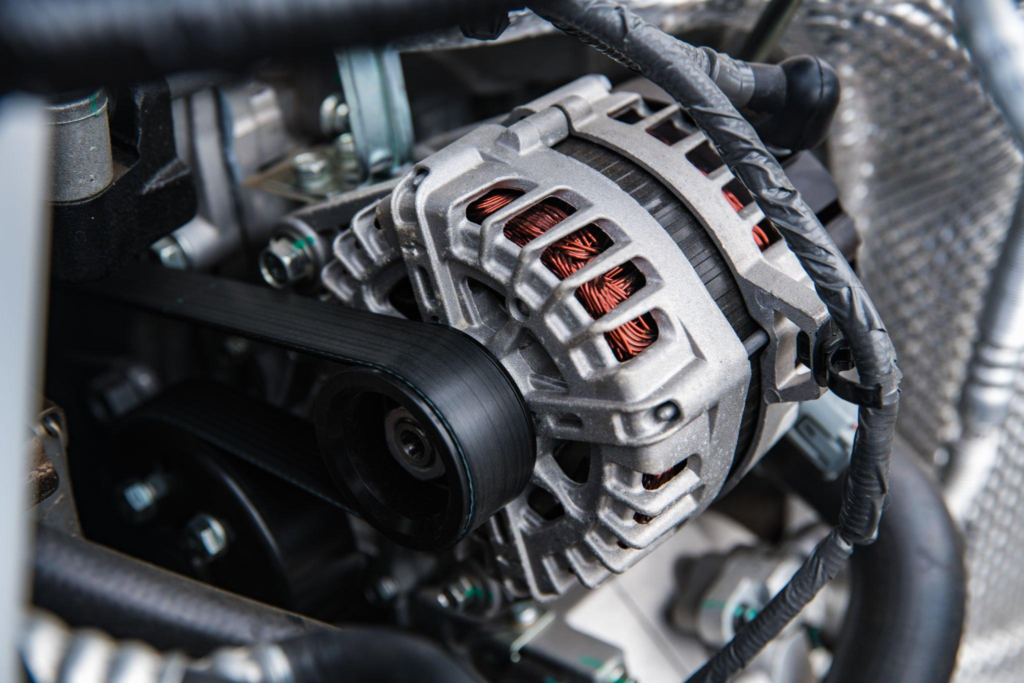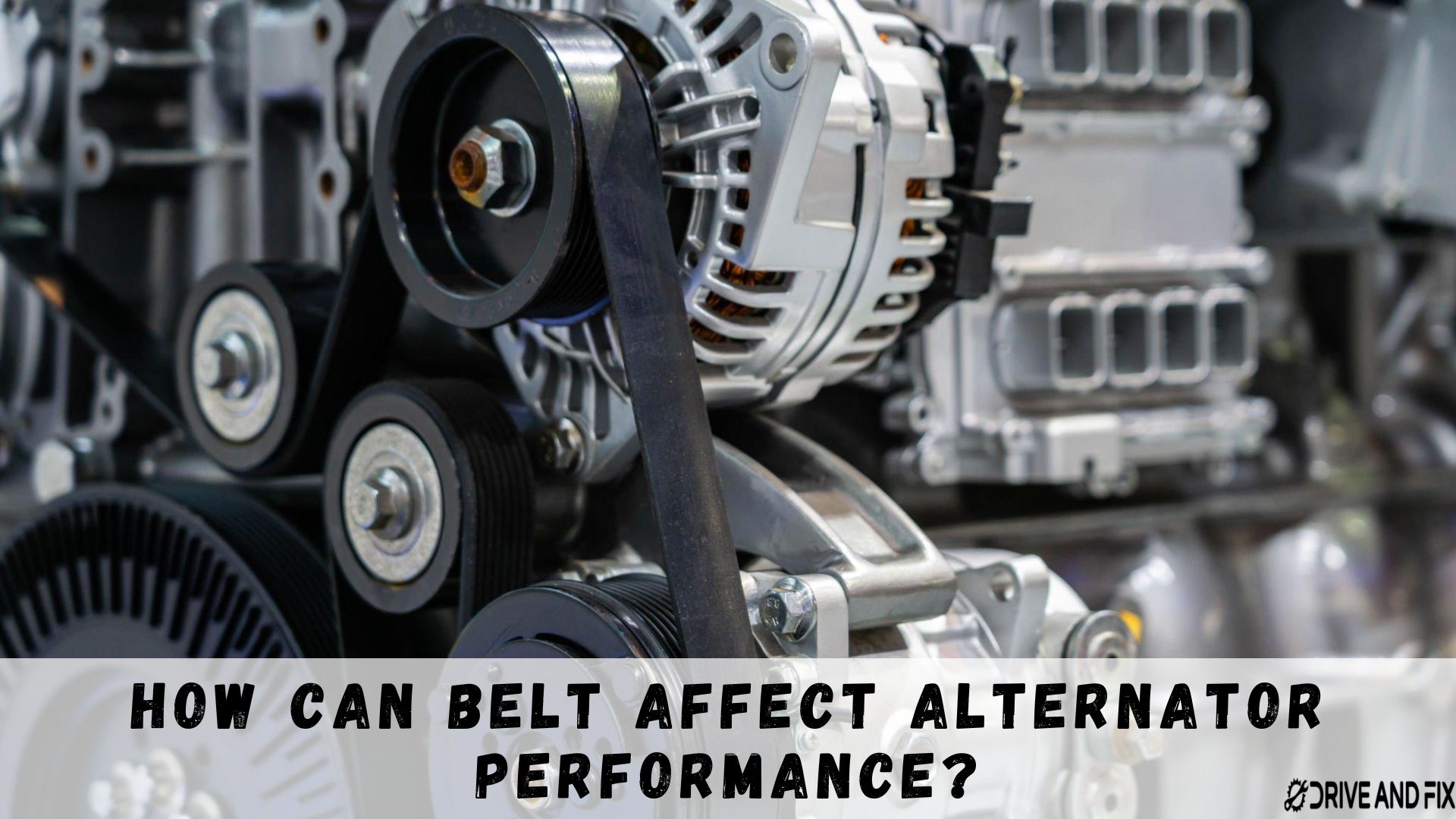Cars are complex machines that rely on many systems and components to function properly. One crucial component of a car’s operation is the alternator, which provides the electrical power needed to keep the vehicle running and its components functioning. However, many may not realize that the alternator’s performance relies heavily on the vehicle’s serpentine belt or V-belt. Therefore, it’s crucial to understand how the belt and alternator work together and how can belt affect alternator performance.
We will delve into the intricacies of the alternator-belt relationship, discuss the signs of a malfunctioning belt and alternator, explore how a bad belt affects the alternator, and provide tips for maintaining and repairing these critical components to ensure a healthy and reliable vehicle.
How The Belt Works With The Alternator
The serpentine belt or V-belt is what drives the alternator. When the engine runs, the belt spins the alternator’s rotor, generating an electromagnetic field. As the rotor spins within the field, it produces an electrical current, which the alternator converts into usable electricity that powers the vehicle’s electrical system and recharges the battery.
Components Of The Belt System
The serpentine belt or V-belt is part of a more extensive system with several components that drive the alternator and other accessories. These components include the belt tensioner, idler pulleys, and alternator pulleys. The belt tensioner keeps the belt tight, while the idler pulleys help guide the belt around the other components. The alternator pulley is what the belt spins to generate electricity.
Common Belt Types
Two main types of belts are used in vehicles:
- Serpentine belts: Serpentine belts are flat, wider belts that wrap around multiple pulleys in a serpentine pattern, hence the name.
- V-belts: These are narrower and have a V-shaped cross-section that fits into the groove of the pulleys.
Serpentine belts are commonly used in newer vehicles, while V-belts are often found in older models. However, both belts perform the same function of driving the alternator and other accessories.
Signs Of A Malfunctioning Belt And Alternator

A malfunctioning belt or alternator can cause various problems in a vehicle. The below signs may indicate a problem with the belt or alternator:
Common Symptoms of a bad belt
- Squealing or chirping noise: If you hear a high-pitched noise from the engine, it may indicate a loose or worn-out belt.
- Belt slippage: If the belt slips or comes off the pulleys, it can cause the alternator to stop spinning, resulting in a loss of electrical power.
- Cracks or wear: When the belt is visibly cracked or worn, it may need to be replaced.
Indicators of a Failing Alternator

- Dimming lights
If your headlights or dashboard lights are dimming or flickering, it may be a sign that the alternator is not generating enough power. A failing voltage regulator, a worn-out belt, or a faulty alternator can cause this. As the electrical system loses power, you may also notice a decrease in the performance of other electrical accessories, such as power windows or the audio system.
- Battery warning light
When the battery warning light on the dashboard comes on, it may indicate a problem with the alternator or battery. This light is shaped like a battery and may be red or yellow. It indicates that the vehicle’s electrical system is not receiving enough power from the alternator, and the battery may not be charging correctly.
You May Also Like: What to Do When Your Battery Light Stays On After Key Pulled?
- Electrical problems
A failing alternator can cause various electrical problems, such as power windows that move slowly or an audio system that cuts in and out. These problems are often intermittent and may be more noticeable when the engine is idling or at low speeds. The alternator is responsible for supplying power to the vehicle’s electrical system, so any issues with the alternator can affect the performance of other electrical components.
How to Diagnose a Bad Belt or Alternator
You can try these methods to diagnose a bad belt or alternator
- Visual inspection of the belt: You can visually inspect the belt for signs of wear or damage. Look for cracks, fraying, or any signs of contamination with oil or other fluids. Check the belt tension by pressing down on the belt between two pulleys. If the belt is overly loose or tight, it may need to be adjusted or replaced.
- Testing the alternator output voltage: Use a multimeter to test the alternator’s output voltage. With the engine running, connect the multimeter’s positive lead to the battery’s positive terminal and the negative lead to the negative terminal. The voltage reading should be between 13.5 and 15 volts. If the reading is lower than this range, it may indicate a problem with the alternator or voltage regulator.
- Diagnostic test by an auto mechanic: An auto mechanic can perform a diagnostic test to determine the source of the problem. They can use specialized equipment to test the alternator’s output and check for any faults in the electrical system. They can also visually inspect the belt and pulleys to identify any signs of wear or damage.
Can Belt Affect The Alternator- Negative Effects

Yes, a malfunctioning or worn-out belt can affect the alternator’s performance in your vehicle. The alternator relies on the engine’s mechanical power to generate electricity and recharge the battery, and the serpentine belt or V-belt is what drives the alternator.
Here are some ways a bad belt can affect the alternator:
- Reduced electrical output
The alternator uses the belt to turn the pulley and generate electrical power. A worn or loose belt can slip or fail to grip the pulley properly, reducing the alternator’s output. This can cause the vehicle’s electrical system to operate at a lower voltage, resulting in poor performance of electrical accessories such as headlights, power windows, or audio systems.
- Dimming lights and weak battery
As the alternator produces less electrical power due to a bad belt, the vehicle’s battery may not be recharged adequately. This can cause the battery to weaken and eventually fail, resulting in difficulty starting the engine or dimming lights. The battery also powers the electrical system when the engine is turned off, so a weak battery can cause the electrical accessories to function poorly.
- Engine stalling and other issues
A lousy belt can cause the engine to stall or fail to start altogether, as the alternator is responsible for supplying power to the engine’s ignition system. A malfunctioning alternator can also cause other issues, such as rough engine idle, reduced fuel economy, or warning lights on the dashboard.
Maintenance and Repair of The belt and Alternator
Regularly inspect and replace the belt and pulleys for signs of wear or damage. The belt should be replaced if it shows signs of cracking, fraying, or contamination with oil or other fluids. The belt’s tension should also be checked periodically and adjusted if necessary. In addition, the alternator should be inspected for signs of wear, such as worn bearings or a loose pulley.
Steps to Replace a Serpentine Belt
- Locate the belt routing diagram in the engine compartment or owner’s manual.
- Use a wrench or socket to release the tension on the belt tensioner and remove the old belt.
- Install the new belt, following the routing diagram.
- Use the wrench or socket to release the tensioner and install the new belt onto the pulleys.
- Check the tension of the new belt and adjust it if necessary.
Read Also: Why It Feels Like Rumble Strips When Accelerating My Car?
Alternator Repair and Replacement Options
If the alternator is damaged or worn beyond repair, you need to replace it. Replacement alternators can be purchased from auto parts stores or online retailers. Choose a replacement alternator compatible with your vehicle’s make and model.
Final Thoughts
How Can Belt Affect Alternator Performance? The alternator and belt work together to power the vehicle’s electrical system, and a malfunction in one can lead to problems with the other. Conduct regular inspections and maintain the belt and alternator to prevent issues and ensure reliable vehicle performance. Signs of a bad belt or alternator include dimming lights, a weak battery, and engine stalling. If you suspect a problem, it’s best to consult a qualified mechanic for professional diagnosis and repair services. Proper maintenance and repair allow the belt and alternator to function efficiently and keep your vehicle running smoothly.
Relevant Resources:
7 Reasons Why Air Gets Hot When Not Accelerating
SOLVING Toyota Tacoma AC LIGHT Blinking In Easy Steps
Do Red Lug Nuts Look Good On Black Wheels?
Passenger Seat Stuck In Recline – Causes, Troubleshooting, And Repairs


